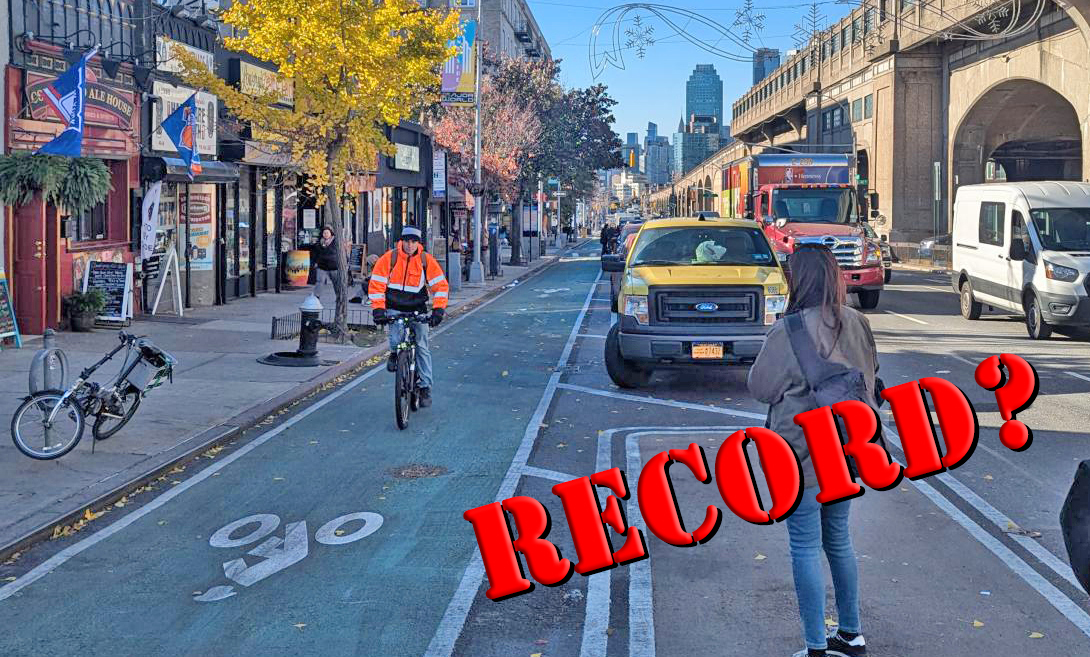
A Streetsblog reader reports from Lower Manhattan:
DOT is removing a series of stop signs from a five block street along the river in Battery Park City for reasons explained below. The street is lined on one side by a heavily-used waterfront park, and the other by residential apartment buildings and entrances to other parks. The area is home to many small children and seniors, who are fighting the DOT change. My instinct is to agree, but I also know that some new thinking favors fewer traffic controls. Are there any examples around the city where both approaches have been tested? (Editors note: there was this in Red Hook last summer and last fall this same issue came up in Boerum Hill)
The following is the text of a memo sent by the NYC Dept. of Transportation to concerned residents in response to their input about the changes in traffic calming measures around the northern neighborhood of Battery Park City:
To Whom It May Concern:
This is in response to your concerns regarding the intersection controls in the north neighborhood of Battery Park City. The Department of Transportation shares your concern for pedestrian and vehicular safety on the streets of Battery Park City. However, the installation of inappropriate traffic controls does not make streets safer but can, in fact, compromise safety for all.
Unwarranted stop signs create problems at both the intersection and along the roadway by:
* encouraging motorists to drive faster between intersections. Placing stop signs on very low-volume streets promotes speeding between the stop signs as drivers try to offset delays caused by stopping at every intersection;
* encouraging violation of traffic laws since as the number of stop signs increase (so that nearly every intersection has one) the rate of stop sign violations tends to increase;
* increasing the chances that drivers will disregard conflicting vehicle and pedestrian traffic, which raises the risk of collisions.
Multi-way stop signs on all approaches do not necessarily improve pedestrian safety. Pedestrians in stop sign-congested neighborhoods often have a false sense of security about crossing streets with multi-way stop signs. They can create confusion between the pedestrian and driver as to who has the right-of-way, thereby increasing the risk that one will make an improper decision.
Stop signs are never installed as a routine cure-all approach to prevent collisions at intersections. They are only installed after an engineering study determines that a need exists.
It is with this concern for traffic safety that we have made several adjustments to controls that were inappropriately installed in the past.
When the Battery Park City Authority (BPCA) built and opened the streets in Battery Park City, they improperly installed intersection controls throughout the neighborhood. This included the installation of multi-way stop signs without performing standard traffic engineering studies to determine whether such controls were proper.
Last year the department was asked to meet with the BPCA to discuss their security concerns. At that time, we re-iterated (with BPCA and their traffic consultant) our objections regarding the stop signs and other intersection controls that had been improperly installed. At that meeting BPCA directed their consultant to provide the department with data and an analysis from which it could determine if the multi-way stop signs were installed properly. The data include information regarding the number of pedestrians and vehicles traveling through the intersections, the number of gaps in the traffic stream to safely accommodate pedestrian crossings and relevant crash history. Using this data, and applying the federal warrants in as broad a manner as possible, DOT along with BPCA's consultant made the following determinations:
Ten intersections were analyzed:
* Four intersections met the warrants for stop signs and the existing signs would be upgraded and remain.
* Three intersections (River Terrace at Warren and at Murray Streets and North End Avenue at Murray Street) did not meet warrants and the stop signs would be removed.
* Three intersections met the warrants for a traffic signal and the existing stop signs would be retained until such time as the signals are installed.
It is our ongoing goal to provide for the safest streets possible citywide. In that regard we will continue to work with the BPCA to monitor conditions to ensure that all intersections are regulated appropriately.
Sincerely yours,
Lori Ardito
Lower Manhattan Borough Commissioner
Image: Darius + Downey via Good Magazine





